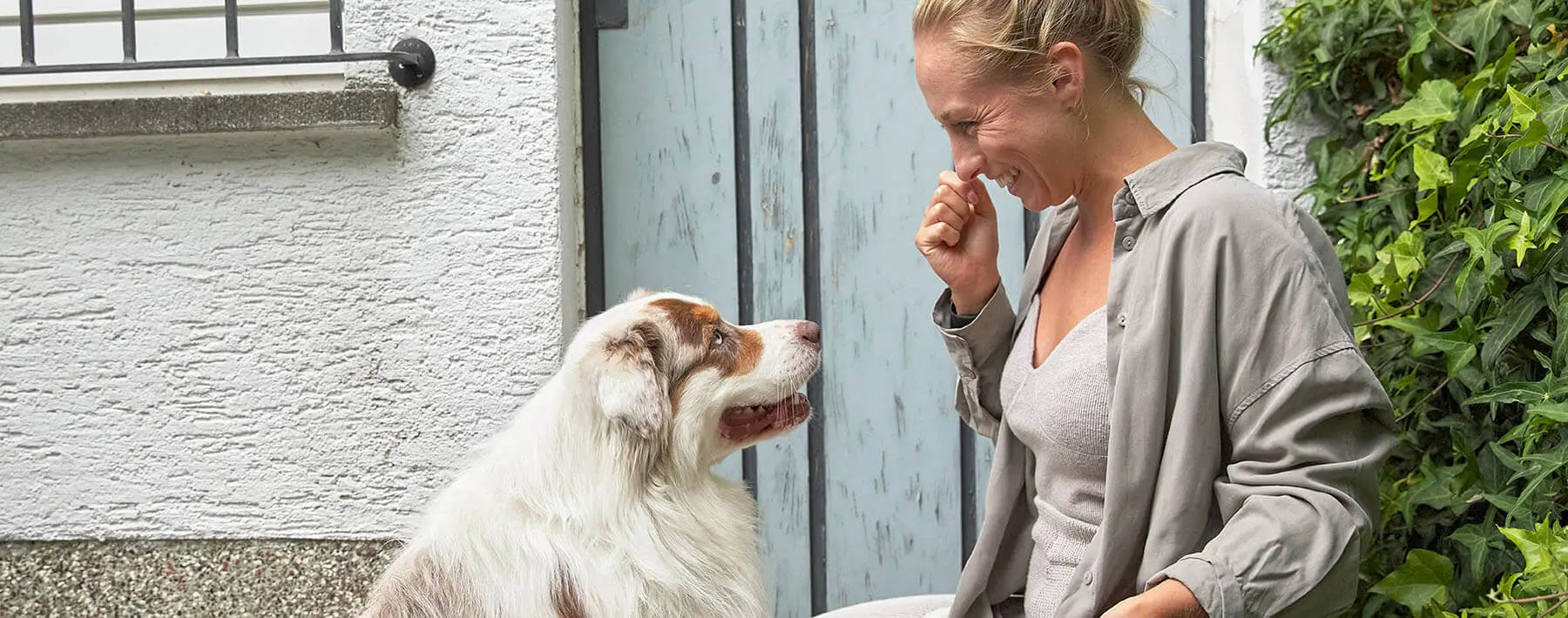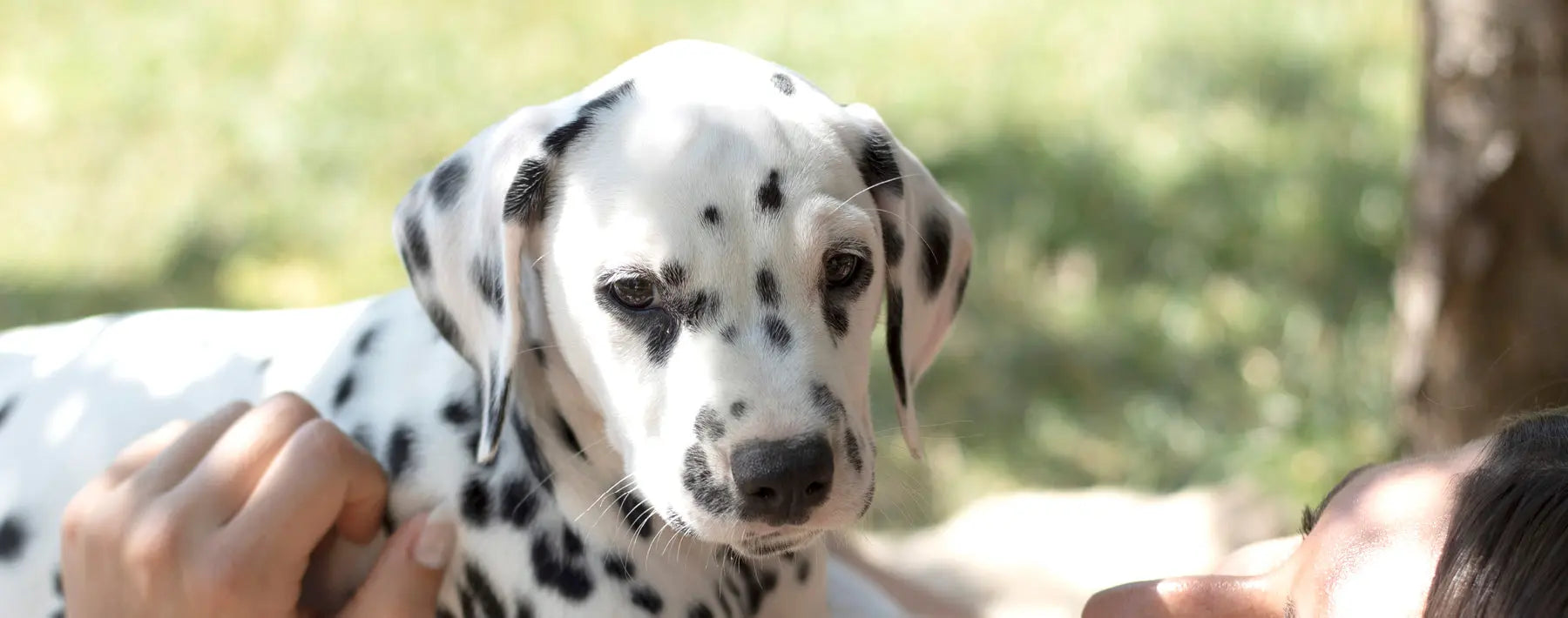
Learn to understand dog body language
How well do you know your dog? Do you always understand what he wants to tell you with his body language and his acoustic signals?
Dogs generally communicate using three different types of communication: Since the gesture can be recognized from a distance, it is particularly suitable for communicating over longer distances. To communicate over short distances, dogs use facial signals, such as the orientation of their ears. In addition, dogs also have a large repertoire of vocalizations, such as barking, yelping or growling. However, most communication is non-verbal.
In this PALOPA blog post we give you tips to better understand your dog's expressive behavior and body language. You will get to know your dog's different signals and find out exactly what they mean.

Dog lies on his back
When your dog lies on his back, he is demonstrating his submissiveness, but also his trust and love for you as his master. He shows his most vulnerable side and shows that he feels safe and secure with you.
Importance of Dog Tail Posture
Your dog's tail or tail also sends a variety of signals. It can swing from side to side in a friendly wagging tail. When angry, your dog can also raise its tail straight up. If your dog tucks its tail or even tucks it between its hind legs, this is a sign of fear or insecurity.
PALOPA tip: The dog's body language is not always clear. Because your dog is not always in a friendly mood when he wags his tail. Generally, wagging expresses a state of excitement. This can range from happily waiting for you to a rather aggressive state of being. This depends entirely on the respective situation. So be sure to always look at your dog’s entire posture!

Change in body size
If you look at your dog's body size, you can distinguish the following: If he makes himself very large, inflates his torso and shifts his body weight forward, your four-legged friend wants to express dominance and self-confidence. On the other hand, if he makes himself particularly small, puts on his fur and squats down, he is insecure or even afraid.
Ears are flattened
The way your dog's ears are positioned also reveals a lot about his mood and feelings. If they are directed backwards, meaning your dog flattens his ears, this is usually a sign of submission. If your dog's ears are straight, it indicates self-confidence and alertness.
Back fur is erect
When your dog puffs up his back, he is expressing irritation or a clear threat. By setting up the “comb” he wants to make it look bigger and more massive.
Meaning of Dog Barking
Dogs bark when they want to tell you or their peers something. But not all barking is the same. The best way to find out what your four-legged friend wants to communicate to you with his barking is to look at it in the context of accompanying body language and facial expressions. He may want to get attention, warn you, or play with you. It is also possible that your friend is bored and feels under-challenged.
Basically, however, it can be said that lighter tones are usually meant to be friendly and playful. On the other hand, lower tones, which can sometimes mix with a growl, are a signal that your dog feels threatened or is giving a warning.

Meaning of Growl
Very important in advance: Growling should always be taken seriously. Growling is a warning and is part of your dog's innate behavioral repertoire, which is necessary for survival. Growling primarily means that the dog is in a threatening and unpleasant situation. It is intended to make it clear to the other person that further rapprochement is not desired.
If your dog growls, you shouldn't punish him straight away, but rather find out the cause of the growling. Possible causes can be: pain, discomfort, fear, prey defense or even frustration.
Appeasement signals in dogs
Appeasement signals are behavioral patterns that are deeply rooted in dog evolution. If your dog feels uncomfortable or stressed, he will use this and try to de-escalate at the same time. This is intended to appease the other person in order to avoid a confrontation. Below we will tell you about three different calming signals from your dog.
yawning
Most of the time your dog yawns when he is in an exciting situation and tries to calm himself down by yawning. Maybe you know this: Before you go for a walk together, your dog can hardly wait and taps his paws back and forth and wags his tail. Meanwhile he yawns because he is full of anticipation and excitement and tries to calm himself down this way.
Aversion
Turn away from the other person, show your back and avoid direct eye contact. You can especially observe this behavior when people or other dogs get too physically close to your dog and he feels restricted in a situation. In order to defuse the situation, he turns away. Therefore, make sure to give your dog his own space at all times.
Splitting
Maybe this situation sounds familiar to you: You want to hug your friend, but your dog suddenly squeezes between the two of you. Most of the time, we humans interpret this behavior as jealousy or dominance, but in reality it is a completely natural appeasement signal. For your dog, it seems as if this physical closeness could end in a conflict. He tries to avoid this by “splitting” you. Dogs also practice this behavior among themselves.
We hope that with the help of our explanations you will now understand your dog's signals and body language better and that you will be able to better assess various situations in everyday life. Of course, there are many other communication signals that your dog can send. Now you have an overview of the most important ones.

Want even more dog knowledge? Become part of the PALOPA community! Together with the experts from the HUNDIVERSUM ®, we regularly provide you with tips and information and look forward to a regular exchange.
Did you like the blog post? Then always stay up to date with our newsletter and be automatically notified about new blog posts. You can also get great discounts and freebies. Here go to registration.



Leave a comment
This site is protected by reCAPTCHA and the Google Privacy Policy and Terms of Service apply.